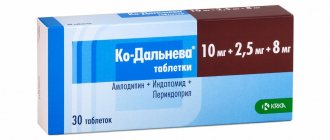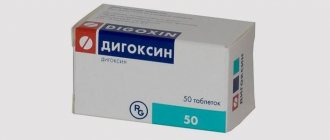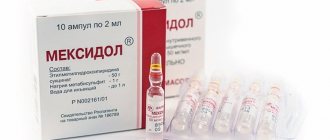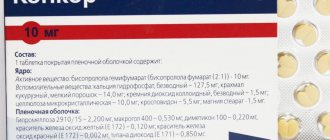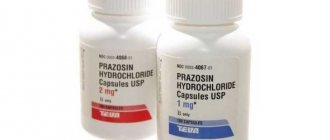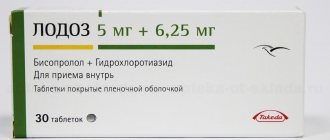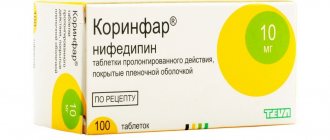In what form is the medicine available?
The medicine is prescribed when symptoms appear that indicate the formation of blood clots in the vessels. The components prevent the formation of blood clots, reducing the risk of various complications, including strokes and heart attacks.
The presented drug is produced in the form of tablets. Thus, the drug is intended for oral administration.
1 tablet contains 75 mg of the active ingredient. The main active substance is clopidogrel bisulfate. Additional components of the tablets are starch, lactose, cellulose, calcium stearate. With their help, a tablet shell is formed, which dissolves under the influence of digestive juices.
Indications for Clopidogrel
The main indication for taking this medicine is myocardial infarction. Clopidogrel is prescribed together with acetylsalicylic acid as early as possible, even at the stage of pre-hospital care (if possible). It can also be used in isolation if the patient cannot tolerate aspirin. The duration of treatment is determined individually and in most cases is at least 1 year.
Before coronary artery bypass surgery, the drug should be discontinued 5 to 7 days before the intervention to reduce the risk of bleeding. The same should be done before other interventions, for example, abdominal surgeries.
Admission for a year is required for patients who have undergone stenting of the coronary arteries. In this case, the drug is often combined with aspirin.
Other indications for prescribing clopidogrel:
- stroke (ischemic);
- acute coronary syndrome, in particular unstable angina.
Unstable angina is an indication for the use of Clopidogrel.
In combination with acetylsalicylic acid, the drug is also prescribed for atrial fibrillation if the patient:
- there is at least one risk factor for cardiovascular complications (diabetes, smoking, excess weight, high cholesterol, hypertension);
- it is not possible to use indirect (Warfarin) or direct anticoagulants (rivaroxaban, which is the active ingredient of the drug Xarelto);
- there is a low probability of bleeding (according to a blood clotting test).
Watch the video about myocardial infarction and its treatment:
Mechanism of action
The drug belongs to the group of antiplatelet agents. This is a group of medications whose action is aimed at preventing the formation of blood clots. Normally, this process occurs through platelet aggregation. When taking Clopidogrel, the ability of platelets to stick together is reduced. Thanks to this, these blood components are not deposited on the surface of blood vessels, preventing the development of atherosclerosis.
Another positive effect is that by reducing the viscosity of the blood, its fluidity increases. Due to this, blood supply to organs and muscle tissue improves. Oxygen starvation, which is a common cause of diseases and complications, is eliminated.
When taken in accordance with the standard dosage regimen, Clopidogrel is very quickly absorbed in the gastrointestinal tract. The maximum concentration in the blood is observed after approximately 45 minutes. from the moment of admission. The drug is absorbed by at least 50%, which indicates moderate bioavailability. The half-life averages 6 hours for the first dose and about 8 hours for repeated use.
Metabolic processes take place in liver cells. Most of the active ingredient is excreted from the body 120 hours after administration. Approximately 50% of metabolites leave the body in urine and about 46% in feces.
Clopidogrel tablets
An unhealthy lifestyle and unbalanced diet lead to the development of atherosclerosis, a disease that has extremely serious consequences. To reduce the risk of atherosclerotic changes, Clopidogrel tablets are prescribed, which inhibit the process of platelet concentration. An additional advantage of the drug is that it can be included in complex antithrombotic therapy in patients who require long-term courses of oral anticoagulant drugs. This category includes patients with prosthetic heart valves.
Compound
The drug is available in the form of biconvex, round tablets coated with a pink film. Composition of one tablet:
| Compound | Weight, in mg |
| clopidogrel hydrosulfite | 97,875 |
| Excipients | |
| pregelatinized starch | 27 |
| lactose anhydrous | 63,125 |
| macrogoal | 8 |
| magnesium stearate | 1 |
| microcrystalline cellulose | 40 |
| hydrogenated castor oil | 3 |
| Shell composition | |
| opadry pink | 9 |
| Hydroxypropyl methylcellulose (hypromellose, croscarmellose sodium) | 2,52 |
| lactose monohydrate | 3,6 |
| titanium dioxide | 2,0484 |
| triacetin | 0,72 |
| charming red dye | 0,108 |
| indigo carmine dye | 0,0036 |
Pharmacodynamics and pharmacokinetics
The drug actively suppresses the process of platelet aggregation and selectively reduces the binding of adenosine diphosphate (ADP) to platelet receptors, and also reduces the ability to activate glycoprotein receptors under the action of adenosine diphosphate. The drug reduces platelet aggregation that is caused by any antagonists by inhibiting their activation by released ADP. The drug molecules bind to platelet ADP receptors, after which platelets permanently lose sensitivity to ADP stimulation.
The effect of inhibiting platelet aggregation occurs two hours after consuming the first dose. The degree of suppression of aggregation increases over 4-7 days and reaches its peak at the end of this period. In this case, the daily intake should be 50-100 mg per day. If atherosclerotic vascular damage is present, then taking the drug prevents the progression of the disease.
After administration, the drug is absorbed in the gastrointestinal tract in a short period of time. The bioavailability of the drug is 50%; this level is not affected by food intake. Metabolism of the drug occurs in the liver. In blood plasma, maximum values are reached an hour after taking the drug. The half-life is eight hours and is excreted by the kidneys and intestines.
Indications for use of the drug Clopidogrel
The drug is prescribed for the treatment and prevention of atherosclerotic diseases and associated complications:
- Prevention of blood clots in patients with myocardial infarction, peripheral arterial occlusive disease, or ischemic stroke.
- Prevention of atherothrombic consequences in patients with acute coronary syndrome:
- Without ST elevation (non-Q wave myocardial infarction or unstable angina), including patients after stenting during percutaneous coronary surgery.
- With an increase in the ST region (acute myocardial infarction) during treatment with medications and when thrombolysis is available.
Indications for use
The medicine has specific properties and purpose, which is why it is prescribed by cardiologists only in the presence of certain disorders. The drug can be used as monotherapy or prescribed in combination with other medications.
Main indications:
- Prevention of complications associated with the formation of blood clots in coronary insufficiency
- Ischemic disease
- Heart attack
- Ischemic stroke
- Unstable angina
The drug is often used for preventive purposes. As a rule, it is prescribed in combination with low doses of acetylsalicylic acid, whose property is to thin the blood.
For preventive purposes, the medicine may be prescribed for arrhythmia or atrial fibrillation. However, Clopidogrel is used only if there are signs indicating an increased risk of atherothrombotic complications.
Indications for use
As a prophylactic measure to prevent complications in the following cases:
- myocardial infarction;
- ischemic stroke;
- peripheral artery occlusion;
- coronary syndrome;
- angina pectoris.
The medication is prescribed to patients with atrial fibrillation, if there is a risk of blood clots. Depending on the severity of the clinical case, it is used as an independent drug or together with Acetylsalicylic acid.
Restrictions and contraindications
The described drug is considered potent. Therefore, it can only be used if precautions are taken. The main one among them is that you cannot take pills if the patient has contraindications.
Main contraindications to taking Clopidogrel:
- Intolerance to active ingredients
- Liver failure
- Acute bleeding (including against the background of gastrointestinal ulcers)
- Lactose intolerance
- Age limit (up to 18 years old)
- Pregnancy (especially in the early stages)
- Prenatal period
- Lactation
Side effects of the drug Terzhinan - everyone needs to know this
Before taking it, you should read the full list of contraindications and consult your doctor. This will eliminate the risk of negative consequences of improperly taking potent medications.
Side effects and contraindications Clopidogrel
From the blood coagulation system: gastrointestinal bleeding is possible; rarely - hemorrhagic stroke.
From the hematopoietic system: neutropenia, thrombocytopenia are possible.
From the digestive system: diarrhea is possible; rarely - abdominal pain, dyspepsia, gastritis, constipation, stomach and duodenal ulcers.
Dermatological reactions: possible skin rash, skin hyperemia, urticaria.
It is also possible to develop reactions from other organs and systems. More details about side effects should be read in the instructions attached to the medication.
Overdose
Symptoms: An overdose of clopidogrel can lead to prolongation of bleeding time and hemorrhagic complications.
Treatment: If bleeding is detected, appropriate therapy should be initiated.
No antidotes for the pharmaceutical activity of clopidogrel have been found. If rapid correction of prolonged bleeding time is necessary, platelet transfusion is recommended.
Contraindications:
- hypersensitivity to clopidogrel;
- severe liver failure;
- acute bleeding, incl. from a peptic ulcer or intracranial hemorrhage;
- pregnancy and breastfeeding;
- children under 18 years of age (safety and effectiveness have not been established);
- for dosage forms containing lactose (additionally) - rare hereditary lactose intolerance, lactase deficiency and glucose-galactose malabsorption.
Rules of application
The tablets are taken orally. It is recommended to accompany each dose with drinking water to activate the process of breaking down the membrane that covers the medicine. In addition, drinking fluids helps reduce the risk of side effects from the gastrointestinal tract.
The dosage regimen is selected individually. The standard dose is 1 tablet per day. This is due to the fact that the active component is absorbed over a long period of time, and in certain concentrations, which cannot be exceeded.
When treating a heart attack, therapy begins 2-3 days after the development of the pathological condition. Therapy continues until the 35th day, during which you need to take 1 tablet per day. In patients with ischemic stroke, the treatment regimen is similar, but the course lasts up to 6 months (depending on the severity and consequences of the pathology for the body).
All about the drug in the video:
With an increased risk of thrombotic pathologies, therapy begins with an increased dose of Clopidogrel. It can reach 300 mg. Subsequently, they drink the standard dose - 75 mg (1 tablet), combined with acetylsalicylic acid.
For patients with coronary syndrome, the medicine is prescribed immediately after the first symptoms of the pathology appear. The minimum course is 4 weeks and can reach 1 year until the optimal therapeutic effect occurs.
How to take Clopidogrel C3?
The instructions give general recommendations regarding the dosage of the drug. For adult patients - 75 mg 1 time per day. The medicine can be taken regardless of meals.
The medicine can be taken regardless of meals.
Treatment of coronary syndrome, unstable angina and previous myocardial infarction should begin with a single high dose of Clopidogrel of 300 mg. On the second and subsequent days of therapy, the dosage is 75 mg.
When taken simultaneously with Aspirin, the dosage of acetylsalicylic acid is 100 mg. Higher doses of Aspirin may lead to bleeding.
Acute myocardial infarction: initial dose - loading 300 mg, subsequently 75 mg. The course of treatment is at least 1 month.
For diabetes
No dose adjustment is required. Dosage is 75 mg per day, the course of treatment is continuous with a high risk of developing thrombophlebitis.
Adverse reactions
Taking Clopidogrel is often accompanied by side effects. This is explained by the specific properties of the drug. Despite the increased risk of adverse reactions, most of them are mild, do not pose a direct threat to the patient’s health and go away on their own when the drug is discontinued.
Adverse reactions include:
- Thrombocytopenia
- Leukopenia
- Some forms of anemia
- Anaphylactic reactions
- Skin rashes
- Dizziness
- Cephalgia
- Confusion
- Drowsiness
- Diarrhea
- Stomach ache
- Constipation
- Nausea and vomiting
- Tissue swelling
One of the possible complications when taking it, which can cause harm to health, is bleeding. It may occur due to blood thinning and changes in the permeability of blood vessels. Patients often experience nosebleeds when taking Clopidogrel. In rare cases, hemorrhages in the eye, bleeding from a post-infarction scar or from the gastrointestinal tract are possible.
Other possible complications include arthritis, muscle pain, serum syndrome, and high body temperature. In some patients, administration is accompanied by hemoptysis, fever, and intracranial bleeding, but these occur in isolated cases.
Cases of overdose
With a single use of doses significantly higher than the standard, an overdose may develop. With this pathology, the risk of bleeding increases, which does not stop for a long time. This, in turn, is fraught with heavy blood loss and associated complications.
If signs of overdose are detected, medical attention is required. Otherwise, there is a possibility of developing complications that threaten the life of the victim. Treatment involves intravenous administration of a composition containing platelets. This allows you to stop bleeding, restoring blood density.
Drug interactions
Taking Clopidogrel with other medications should be done with extreme caution. It is important to take into account the peculiarities of drug interactions, since otherwise it can harm the patient.
It is not recommended to take with the following groups of medications:
- Anticoagulants
- Glycoprotein inhibitors
- Medicines based on Heparin
- Thrombolytic agents
- Non-steroidal anti-inflammatory drugs
- Proton pump inhibitors
In case of violations of pharmacological interaction, drugs affect the effectiveness of each other. As a result, the effect of drugs may be weakened or, on the contrary, enhanced. Both options for the treatment of diseases of the cardiovascular system are considered extremely undesirable, since the patient requires a stable long-term effect.
What you need to know about the drug No-shpa. Release form, detailed instructions for use
Pregnancy and lactation
Women during pregnancy are strictly prohibited from using Clopidogrel. This potent drug can cause damage to the fetus and cause various complications, including freezing and miscarriage.
Therefore, the medicine is not recommended for use at any time.
In rare cases, an exception is made if the intended benefit of the drug significantly outweighs the potential harm. A similar ban applies during the prenatal period. Before giving birth, women are strictly prohibited from taking blood thinning medications. Otherwise, severe bleeding may develop, which can be fatal.
Breastfeeding is also a contraindication to the use of this medicine. The components of the drug can pass into breast milk and enter the baby’s body with it. Newborns and young children are strictly prohibited from taking antiplatelet drugs due to severe side effects.
During pregnancy
To date, there are no full-fledged studies and no experimental basis has been developed on the effect of Clopidogrel on the course of pregnancy and on fetal development. For this reason, the drug is not prescribed during pregnancy. There is no data on the concentrations in which the drug passes into breast milk, so taking Clopidogrel is not recommended during breastfeeding.
Use in pediatrics
The medicine is not prescribed to patients under 18 years of age. This is due to the fact that clinical studies have not been conducted with this age group. Therefore, it is not known how safe it is to use Clopidogrel in children. Because of this, the medicine is not prescribed in childhood and is not used in pediatrics.
Admission for pathologies of the kidneys and liver
In severe forms of liver failure, taking Clopidogrel is strictly prohibited. Firstly, this is due to a certain toxic effect on the organ. Secondly, liver pathologies can be aggravated by portal bleeding, the risk of which increases with antiplatelet drugs.
For kidney pathologies, the medicine is prescribed with caution. This is due to the fact that experience with the use of Clopidogrel in patients with diseases of the excretory system is limited. Because of this, there is a certain risk. Persons with liver or kidney pathologies are given the drug mainly during hospital stays, since there patients are under constant supervision.
Contraindications
It is prohibited to take in the following cases:
- individual intolerance to individual components of the drug;
- severe liver failure;
- ulcer accompanied by the opening of internal bleeding;
- intracranial hemorrhages.
Age limit is under 18 years old. The medicine contains lactose. If a patient is diagnosed with congenital lactose intolerance, taking the drug is strictly prohibited (due to the highest risks of developing side symptoms).
Carefully
Constant monitoring of health status is required (conduct regular examinations and monitor laboratory parameters) during therapy with Clopidogrel C3 in patients with the following diagnoses:
- mild to moderate severity of liver failure;
- previous operations;
- mechanical damage, injuries to internal organs;
- diseases in which there is a high risk of bleeding.
Precautionary measures
The described drug can cause internal bleeding. Therefore, patients who are prescribed systemic administration of Clopidogrel must periodically donate blood for a detailed study. A diagnostic procedure is also required if symptoms indicating bleeding or other side effects of Clopidogrel occur.
Before surgery or other invasive procedures, it is necessary to temporarily interrupt the use of antiplatelet drugs. This must be done 1 week before the intervention. The patient must warn that he is taking a medication that affects platelet activity before any procedures or when prescribing any previously unused medications.
Cost of medicine
You can buy Clopidogrel or its analogs at almost any pharmacy. However, to purchase, the patient must have a prescription issued by the attending physician. Dispensing the drug without a prescription is prohibited.
The minimum cost of medicine in pharmacies is 150 rubles. The price directly depends on the manufacturer and the number of tablets in the package. The average price is 340-400 rubles. The maximum cost of Clopidogrel in pharmacies reaches 700 rubles.
Gargling with Furacilin for a sore throat: how to prepare a solution, proper gargling
Release form of the medicine
Almost all manufacturers produce Clopidogrel in the form of tablets coated with a thin film coating. The exception is Fluder, which is produced in capsules.
Most clopidogrel preparations contain 75 mg of active ingredient. Exceptions: Clapitax (150 and 300 mg tablets) and Plavix (300 mg tablets) .
The number of tablets per package varies. Usually it contains from 7 to 90 tablets, but there are drugs with up to 600 tablets in one package (Lopirel). The more ballet shoes in the box, the more profitable it is to buy such medicine.
Clopidogrel is not available as an injection solution. This is due to the fact that its effect develops rather slowly, but at the same time the drug is well absorbed from the digestive organs.
Analogue drugs
Various types of antiplatelet agents can be used as analogues. They are used to replace Clopidogrel if for certain reasons it is impossible to take this medicine.
There are direct analogues of Clopidogrel (having the same active ingredients) and indirect analogues (have similar pharmacological properties, but different composition) (see Table 1).
| Active Ingredients | Trade names of analogues |
| Clopidogrel | Klopatsin Claudia Cardogrel Clopicor |
| Clopidogrel in combination with acetylsalicylic acid | Clopidogrel Plus Clopigrant Plagril Coplavix Aspigrel |
| Acetylsalicylic acid in combination with magnesium or glycine | Godasal Trombital Fasostabil Cardiomagnyl |
Self-administration of analogue drugs is not allowed. Medicine instead of Clopidogrel should be prescribed by the attending physician, taking into account the clinical picture and other characteristics of the patient’s condition.
All the most important things about the product in the video:
Indications for use Clopidogrel
Prevention of thrombotic complications in patients with myocardial infarction (with a duration of several days to 35 days), ischemic stroke or occlusion of peripheral arteries. In combination with acetylsalicylic acid for the prevention of thrombotic complications in acute coronary syndrome.
Clopidogrel is also used for the prevention of thromboembolic and thrombotic complications, including stroke, in the absence of the possibility of prescribing indirect anticoagulants, for atrial fibrillation (atrial fibrillation), in the presence of risk factors for vascular complications and bleeding (in combination with acetylsalicylic acid).
